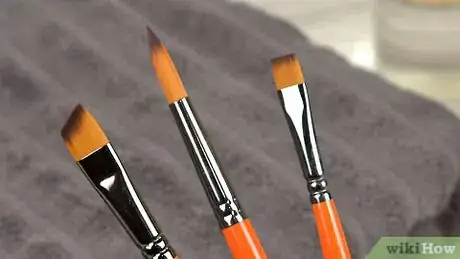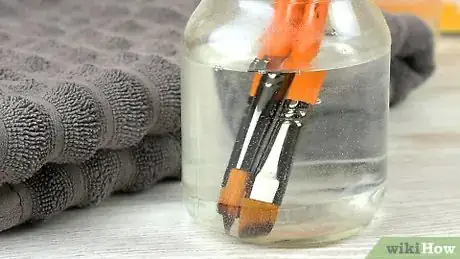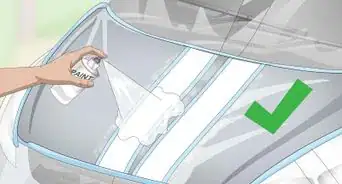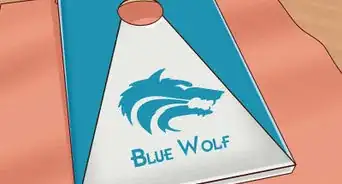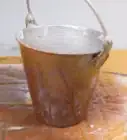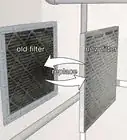This article was co-authored by Jeanine Hattas Wilson. Jeanine Hattas Wilson is a Professional Painter and the President of Hattas Public Murals, Inc. With nearly 20 years of experience, Jeanine specializes in creating, overseeing, designing, and painting murals. Jeanine holds a BA in Advertising from Marquette University and a Studio Painting Minor from The Milwaukee Institute of Art & Design. She has studied at The Atelier Artien in Paris, France, Los Angeles Academy of Figurative Art, and under renowned artists such as Robert Liberace, Michael Siegel, and William Cochran. To date, Hattas Public Murals has painted nearly 5,000 commissioned works of art in homes and commercial and public spaces.
There are 10 references cited in this article, which can be found at the bottom of the page.
This article has been viewed 15,714 times.
It's common for pesky stray paint brush hairs to make their way into your painting, and you might not be sure how to get them out without messing up your artwork. Luckily there are several ways you can try to remove them, as well as ways to prevent this from happening. When you first get a new brush, soak it in water before gently tugging on the bristles, removing any stray hairs before they can get into your painting. Tweezers and palette knives are helpful tools for removing brush hairs that are in your artwork.
Steps
Preventing Brush Hairs from Getting on Your Artwork
-
1Choose high quality brushes for better brush quality. While purchasing cheap paint brushes may seem like an easy alternative to more expensive ones, cheaper brushes will likely have more loose hairs that will get stuck in your painting. Instead, look for high quality brushes that are made well.[1]
- Some great professional brush brands include Winsor & Newton, Princeton, or Blick.
-
2Soak new brushes in warm water for 1-2 minutes. When you first get a brush, it’ll feel stiff when you touch the bristles due to the starch that’s holding its shape. To remove the starch, fill a cup with warm water and let your brush soak in the water for 1-2 minutes.[2]
- Avoid letting your brushes soak for too long, as this can cause damage to the brush and ferrule.
- You only need to soak the brushes to remove the starch if your brush is brand new.
- You can also simply rinse your brush in warm water if you prefer.[3]
Advertisement -
3Pull on the bristles gently to remove stray hairs. Once the brush has soaked, use your thumb and index finger to gently pull loose hairs from the brush.[4] Do this several times, swiping your fingers over the bristles and pulling slightly to see if any of the hairs are loose.[5]
- Blot the brush on a paper towel to remove the excess moisture before tugging on the bristles, if needed.
-
4Wash and reshape your brushes after using them. Caring for your paint brushes is super important so that they stay shaped and keep their bristles intact. Once you’re finished using them, rinse them with water and a special soap for paint brushes to remove the excess paint from the bristles. Use your fingers to shape the bristles, creating a straight point so the brush will dry correctly.[6]
- If you don’t have paint brush soap, a gentle dish soap will work as well.
- For example, if you’re using a brush with a pointed tip, wash the bristles and reshape them into a point while it’s still wet so it will dry in that shape.
-
5Store paint brushes laying flat or hanging upside down. If you’re able to store your brushes upside down as they dry, great! Otherwise, spread the wet brushes out on a towel that’s on a flat, stable surface. Keep the brushes on the towel until they dry completely before placing them in a container vertically.[7]
- If you let your wet brushes dry sitting vertically, it can cause damage as the water seeps into the brush's handle.
- Purchase a special paint brush holder that holds brushes upside down, letting them dry correctly. These can be found online or at specialty art stores.
Removing Brush Hairs from a Painting
-
1Wait for watercolors to dry before removing the hair. If you try to remove a paint brush hair while your watercolor paint is still wet, you’ll likely smear your artwork. Instead, let the watercolor painting dry completely. After that it will be safe to simply wipe away the brush hair that you found on the painting.[8]
- Brush the hair away gently using a dry paintbrush or your fingers.
-
2Use tweezers to remove brush hairs from oil or acrylic paintings. This works whether your painting is wet or not, though it may be easiest when the paint is still damp. Use the tweezers to pick up the brush hair, being careful not to dig too deeply into the painting with the tweezers so you don’t make a mark.[9]
- A palette knife can also work to remove brush hairs. Use the tip of the palette knife to lift the brush hair up, positioning the palette knife under the hair carefully.
-
3Brush the hair using a small brush to wipe it away while the paint is wet. Before the paint has dried, take a small paint brush and brush over the spot with the hair, making the brush hair stand up.[10] Once it pops up, you can either continue brushing it off the side of the painting or pick it up using your fingers.[11]
- This works best if you covered a large surface area with one color, helping any brush strokes resulting from the hair removal blend into your painting.
-
4Scrub the hair away using a non-abrasive pad if the hair won’t come off. If your painting has dried and you can’t get the hair out, find a non-abrasive cleaning pad. Regular sponges that you might use to wash dishes work well, as long as they're soft. Gently rub the spot with the hair using the pad, going in circular motions to help remove the hair.[12]
- Make sure your painting is completely dry before using a pad on it so you don’t accidentally smear your artwork.
- Avoid scrubbing aggressively, as this could ruin your artwork.
Expert Q&A
-
QuestionWhy does my paint brush lose bristles?
 Jeanine Hattas WilsonJeanine Hattas Wilson is a Professional Painter and the President of Hattas Public Murals, Inc. With nearly 20 years of experience, Jeanine specializes in creating, overseeing, designing, and painting murals. Jeanine holds a BA in Advertising from Marquette University and a Studio Painting Minor from The Milwaukee Institute of Art & Design. She has studied at The Atelier Artien in Paris, France, Los Angeles Academy of Figurative Art, and under renowned artists such as Robert Liberace, Michael Siegel, and William Cochran. To date, Hattas Public Murals has painted nearly 5,000 commissioned works of art in homes and commercial and public spaces.
Jeanine Hattas WilsonJeanine Hattas Wilson is a Professional Painter and the President of Hattas Public Murals, Inc. With nearly 20 years of experience, Jeanine specializes in creating, overseeing, designing, and painting murals. Jeanine holds a BA in Advertising from Marquette University and a Studio Painting Minor from The Milwaukee Institute of Art & Design. She has studied at The Atelier Artien in Paris, France, Los Angeles Academy of Figurative Art, and under renowned artists such as Robert Liberace, Michael Siegel, and William Cochran. To date, Hattas Public Murals has painted nearly 5,000 commissioned works of art in homes and commercial and public spaces.
Professional Painter Brand new paintbrushes tend to run into this issue. Before using your new brush, try washing the brush and pulling up the hairs to see if there are any loose strands.
Brand new paintbrushes tend to run into this issue. Before using your new brush, try washing the brush and pulling up the hairs to see if there are any loose strands. -
QuestionIs it okay to leave brush hairs on a painting?
 Jeanine Hattas WilsonJeanine Hattas Wilson is a Professional Painter and the President of Hattas Public Murals, Inc. With nearly 20 years of experience, Jeanine specializes in creating, overseeing, designing, and painting murals. Jeanine holds a BA in Advertising from Marquette University and a Studio Painting Minor from The Milwaukee Institute of Art & Design. She has studied at The Atelier Artien in Paris, France, Los Angeles Academy of Figurative Art, and under renowned artists such as Robert Liberace, Michael Siegel, and William Cochran. To date, Hattas Public Murals has painted nearly 5,000 commissioned works of art in homes and commercial and public spaces.
Jeanine Hattas WilsonJeanine Hattas Wilson is a Professional Painter and the President of Hattas Public Murals, Inc. With nearly 20 years of experience, Jeanine specializes in creating, overseeing, designing, and painting murals. Jeanine holds a BA in Advertising from Marquette University and a Studio Painting Minor from The Milwaukee Institute of Art & Design. She has studied at The Atelier Artien in Paris, France, Los Angeles Academy of Figurative Art, and under renowned artists such as Robert Liberace, Michael Siegel, and William Cochran. To date, Hattas Public Murals has painted nearly 5,000 commissioned works of art in homes and commercial and public spaces.
Professional Painter Yes, it is! In fact, some artists prefer to keep brush hairs on the canvas to highlight the painting process. Others find that brush hairs add a sense of rawness to a painting that can really work well with your style.
Yes, it is! In fact, some artists prefer to keep brush hairs on the canvas to highlight the painting process. Others find that brush hairs add a sense of rawness to a painting that can really work well with your style. -
QuestionHow do you get bristles out of paint?
 Jeanine Hattas WilsonJeanine Hattas Wilson is a Professional Painter and the President of Hattas Public Murals, Inc. With nearly 20 years of experience, Jeanine specializes in creating, overseeing, designing, and painting murals. Jeanine holds a BA in Advertising from Marquette University and a Studio Painting Minor from The Milwaukee Institute of Art & Design. She has studied at The Atelier Artien in Paris, France, Los Angeles Academy of Figurative Art, and under renowned artists such as Robert Liberace, Michael Siegel, and William Cochran. To date, Hattas Public Murals has painted nearly 5,000 commissioned works of art in homes and commercial and public spaces.
Jeanine Hattas WilsonJeanine Hattas Wilson is a Professional Painter and the President of Hattas Public Murals, Inc. With nearly 20 years of experience, Jeanine specializes in creating, overseeing, designing, and painting murals. Jeanine holds a BA in Advertising from Marquette University and a Studio Painting Minor from The Milwaukee Institute of Art & Design. She has studied at The Atelier Artien in Paris, France, Los Angeles Academy of Figurative Art, and under renowned artists such as Robert Liberace, Michael Siegel, and William Cochran. To date, Hattas Public Murals has painted nearly 5,000 commissioned works of art in homes and commercial and public spaces.
Professional Painter Try to slightly jam the brush bristles into the canvas to pull up the hair. Don't bother using your fingers or fingernails.
Try to slightly jam the brush bristles into the canvas to pull up the hair. Don't bother using your fingers or fingernails.
References
- ↑ https://www.youtube.com/watch?v=lukEMROA3gI#t=20s
- ↑ https://www.youtube.com/watch?v=xu5oiDWmFPc#t=2m58s
- ↑ Jeanine Hattas Wilson. Professional Painter. Expert Interview. 11 May 2021.
- ↑ Jeanine Hattas Wilson. Professional Painter. Expert Interview. 11 May 2021.
- ↑ https://www.youtube.com/watch?v=RcZGNtE4O5g#t=1m50s
- ↑ https://www.youtube.com/watch?v=xu5oiDWmFPc#t=32s
- ↑ https://www.youtube.com/watch?v=RcZGNtE4O5g#t=2m40s
- ↑ https://www.youtube.com/watch?v=xu5oiDWmFPc#t=55s
- ↑ https://www.youtube.com/watch?v=xu5oiDWmFPc#t=1m4s
- ↑ Jeanine Hattas Wilson. Professional Painter. Expert Interview. 11 May 2021.
- ↑ https://www.easy-oil-painting-techniques.org/cleaning-brush-hairs-off-of-painting-before-starting-next-layer.html
- ↑ https://www.youtube.com/watch?v=lukEMROA3gI#t=55s
